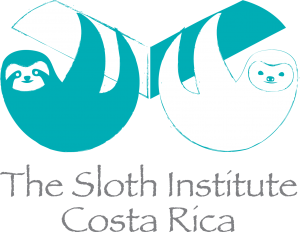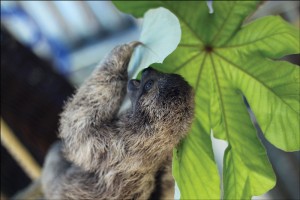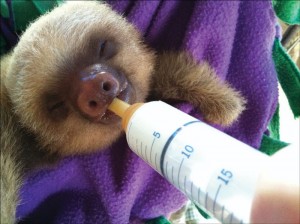Diary of a Sloth Nanny
 Hello, this is Jill (the sloth nanny), reporting from the sloth nursery at KSTR where The Sloth Institute is working in collaboration with KSTR to raise its baby-orphaned sloths. I’ve been volunteering here for about a month, working night and day to take care of the eleven sloths currently in rehab. Sloths have seen a popularity explosion thanks to some viral internet videos, but few people realize that it takes a tremendous amount of time and dedication to raise and release them back to the wild.
Hello, this is Jill (the sloth nanny), reporting from the sloth nursery at KSTR where The Sloth Institute is working in collaboration with KSTR to raise its baby-orphaned sloths. I’ve been volunteering here for about a month, working night and day to take care of the eleven sloths currently in rehab. Sloths have seen a popularity explosion thanks to some viral internet videos, but few people realize that it takes a tremendous amount of time and dedication to raise and release them back to the wild.
My daily routine starts at 7 am with hand-feeding all of the baby sloths. Eight of the eleven sloths are less than a year old and need frequent feedings and monitoring. Most things are slow with sloths, including their ability to drink the milk from the syringes. The feedings take patience, as hand-feeding all of the babies can be an almost two hour event. All together, there are four milk feedings per day, with one of those being overnight. This changes if we receive an infant sloth. They need feedings every two hours, around the clock. Between the late nursery feedings, I leave to take care of the two adult sloths, Ellen and Kermie, that are to be released this year. They are nocturnal two-toed sloths so each evening we hang fresh leaves and vegetables around their enclosure for them to find.
 Throughout the day, we also give the young sloths leaves and flowers to munch on. Their favorites are hibiscus, guarumo (cecropia), mango, cinnamon, guácimo, and beach almond. All of these are found in their natural habitat and are eaten by wild sloths. Because the sloths eat so many leaves in a day, it takes several people to gather enough for them. No trip to town is complete without a leaf-collecting stop. We will suffer through torrential rains and aggressive ant attacks to bring leaves to the babies.
Throughout the day, we also give the young sloths leaves and flowers to munch on. Their favorites are hibiscus, guarumo (cecropia), mango, cinnamon, guácimo, and beach almond. All of these are found in their natural habitat and are eaten by wild sloths. Because the sloths eat so many leaves in a day, it takes several people to gather enough for them. No trip to town is complete without a leaf-collecting stop. We will suffer through torrential rains and aggressive ant attacks to bring leaves to the babies.
The best part of my sloth-filled day is when I bring the baby sloths outside for some exercise. They can spend a few hours climbing, eating, or just napping in one of the trees outside the nursery. It is a chance for them to practice skills necessary for their survival after release. For me, it is a glimpse into their future as wild sloths. This is the ultimate goal of the rehabilitation department.
We can receive a new sloth at any time and the most critical patients stay at the clinic at Kids Saving the Rainforest. We may make several clinic trips to monitor, feed, and treat an injured adult sloth. Recently, we were caring for an electrocuted three-toed sloth that required a front limb amputation. Despite our best efforts, this one’s internal injuries were too extensive and it did not make it.
 Many people might consider this to be a dream job- taking care of adorable baby sloths all day. While there is no doubt that it is rewarding work, it is also a very demanding job filled with stress and occasional heartache. Sloths are delicate creatures and you have to constantly be taking note of subtle changes. Any slight change in health or habits is taken seriously. By the time you see the slightest difference, it may already be too late to save them. While Sam was away in the U.S. a few weeks ago, several of the young sloths suddenly changed their eating habits. I spent extra time monitoring their vitals and encouraging them to eat between vet checks, all while worrying that I wasn’t doing something right. Because veterinary knowledge is not extensive for sloths, we are still learning how to help them. Each difficult case teaches us something that will help the next sloth that comes through the clinic or nursery.
Many people might consider this to be a dream job- taking care of adorable baby sloths all day. While there is no doubt that it is rewarding work, it is also a very demanding job filled with stress and occasional heartache. Sloths are delicate creatures and you have to constantly be taking note of subtle changes. Any slight change in health or habits is taken seriously. By the time you see the slightest difference, it may already be too late to save them. While Sam was away in the U.S. a few weeks ago, several of the young sloths suddenly changed their eating habits. I spent extra time monitoring their vitals and encouraging them to eat between vet checks, all while worrying that I wasn’t doing something right. Because veterinary knowledge is not extensive for sloths, we are still learning how to help them. Each difficult case teaches us something that will help the next sloth that comes through the clinic or nursery.
About The Sloth Institute of Costa Rica (theslothinstitutecostarica.org): The mission of The Sloth Institute Costa Rica is to enhance the well-being and conservation of wild and captive sloths through research and education. TSI is also dedicated to collaborating with sloth rehabilitation programs with a current focus on the sloths at Kids Saving the Rainforest in Manuel Antonio, Costa Rica. For further information or to donate to this project, email [email protected] or visit www.theslothinstitutecostarica.org.
